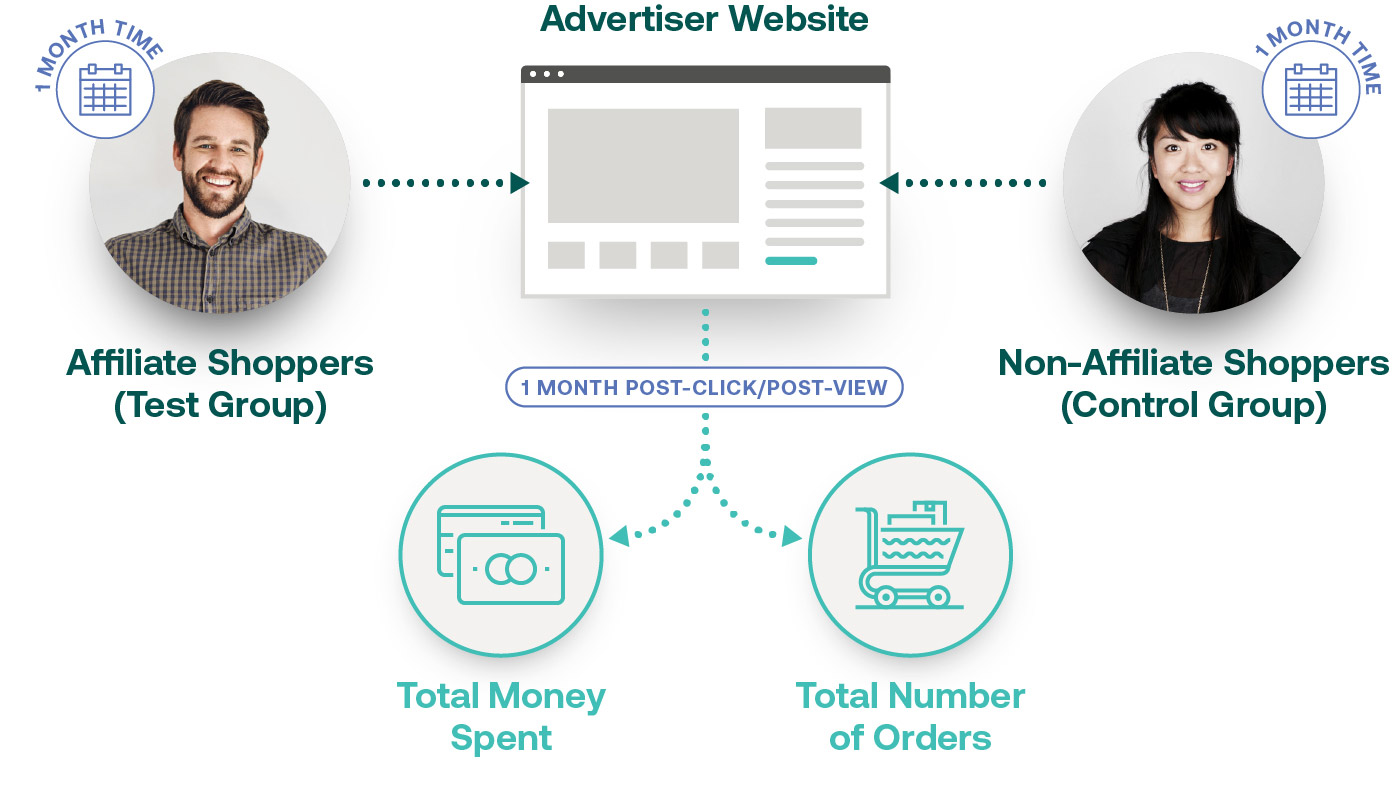A Study of Affiliate Incrementality

A Study of Affiliate Incrementality



Digital marketing today includes a wide range of channels that are vying for investment. With a myriad of ways for consumers to connect with brands, the bar has been set higher than ever for channels to prove their value. For brands to intelligently invest, it is important for them to truly understand the value each channel delivers. In this vein, CJ set out to measure the incremental value that the affiliate channel delivers to brands.
Using test and control methodology, we split a population of 20.2M shoppers into two groups with only one difference between them: the test group had an affiliate click. We further controlled for brand awareness, seasonality, and time to conversion.
We found that overall, when a shopper interacts with the affiliate channel, they are more likely to purchase, spend more with each purchase, and make more subsequent purchases. Furthermore, we also found that shopper interaction with the affiliate channel positively affected results for both new-to-file and return customers.
These results are validation that the customer-centric approach of the affiliate channel is providing value to consumers as well as brands. Consumers seek out publishers to help answer questions around where to buy, what to buy, and how much to spend. This third-party perspective lends credibility to brands with whom a consumer may not be familiar, leading to higher new-to-file rates. Repeat customers also benefit from an unbiased resource. Affiliate marketing provides incremental value because these wide variety of customer needs are met through publishers who provide this information and make consumers confident in their choices.
To put these findings into practice, brands should invest more in the affiliate channel to leverage the confidence publishers bring to shoppers by credibly meeting consumer needs - which results in higher conversion rates and spend, across both new and repeat customers.
Incrementality is a subset of the overall value that was measured. It focuses on the additional value the channel provides that would not have occurred without the channel present. Incrementality asks the question, 'Did that set of marketing touch points influence customer actions (knowingly or unknowingly) to drive more value?' Incrementality for any marketing channel is about successfully influencing shopper behaviour and meeting consumer needs such that you gain more value with the channel versus without it.
Incrementality is not attribution. Attribution is a transaction level analysis that allows you to model the impact of multiple marketing touch points for any given transaction. Incrementality, on the other hand, looks at the consumers/people who drove those transactions; it looks at the behaviour of these people and how having a certain marketing channel in the mix impacts your business outcome. Incrementality is a measurement of behaviour across groups and is independent of an attribution model. Understanding incrementality can help you create a better model for attribution.
This incrementality study used the widely accepted test and control methodology. The test group of users exhibits the behaviour that is under study: in this case, affiliate clicks. The control group of users are similar to the test group, but the only difference is they did not click on any affiliate links during the testing period. By analysing the differences in behaviour between the test and control groups, the impact that affiliate clicks have on key performance metrics can be measured.
Brands included in this study are highly recognisable household brands, with a combined total revenue of approximately US$31B.
Data Source
Retail client CRM customer files, transaction data, site visit data, and affiliate click data
Time Frame
September 2018
Total Population Size
20.2M (1.1M Affiliate Shoppers, 19.1M Non-Affiliate Shoppers)
Total Transaction Volume
5.5M Retail Transactions
Affiliate Shoppers (Test Group)
Visitors to an Advertiser’s website who have clicked on any affiliate link at any point during September 2018 (1.1M Affiliate Shoppers)
Non-Affiliate Shoppers (Control Group)
Visitors to the Advertisers’ site who did not have an affiliate click during September 2018 (19.1M Non-Affiliate Shoppers)
Brand Awareness
The Non-Affiliate Shopper group members had to at least visit the brand’s site during September 2018. This controls for shoppers’ brand awareness. It also controls for the fact that these shoppers are in market and already know about the brand.
Seasonality
Both groups were observed and measured during the exact same time frame.
Time to Conversion
Both groups were given the same amount of time with which to engage with the affiliate channel or brand, as well as to convert. The Affiliate Shopper group was measured up to 30 days from their affiliate click(s). Similarly, the Non-Affiliate Shopper group was measured up to 30 days from their site visit(s). This 30-day period allows both groups of shoppers an equal opportunity to convert and controls for potential differences in time to conversion.

Individuals
Deterministically and cross-device matched to unique and anonymous customer profiles. These profiles may be associated with multiple emails, devices, and cookies. This matching methodology eliminates double counting between user groups and allows us to accurately measure their shopping behaviour.
Shopper
Individuals in either the Affiliate Shopper (Test) or Non-Affiliate Shopper (Control) group.
Customer
Shoppers who have made at least one purchase with the respective brand.
Shopper to Customer Conversion Rate
Total customers divided by the number of shoppers.
Average Order Value
Total revenue divided by total number of orders.
Orders per Customer
Total orders divided by total number of customers.
Revenue per Customer
Total revenue in one group divided by total number of customers in the same group.
Revenue per Shopper
Total sales revenue divided by the total number of shoppers.
New Customer
Brands define their custom new-to-file definition. If no custom definition was given, then CJ defines a new customer as someone who has not purchased from the brand in the past 2 years.
Return Customer
Brands custom define a return customer definition. If no custom definition is given, then CJ defines a return customer as someone who has purchased from the brand within the past 2 years.
During the observation timeframe, when comparing Affiliate Shopper performance to Non-Affiliate shopper performance...
As a total group, Affiliate Shoppers complete more purchases, spend more on each purchase and convert at a higher rate than Non-Affiliate Shoppers.
* This statistically significant value (p-value = 0.00) is earned when the affiliate channel is present; it is not otherwise earned when the channel is not present - thus making it incremental value.
During the observation timeframe, when looking at new customer performance for the Affiliate Shopper group compared to the Non-Affiliate Shopper group...
While new customers converted through affiliate complete about the same number of orders and spend less than Non-Affiliate Shoppers, affiliate is much stronger at getting new customers to ultimately convert when compared to non-affiliate channels.
This statistically significant value (p-value = 0.00) is earned when the affiliate channel is present; it is not otherwise earned when the channel is not present - thus making it incremental value.
During the observation time frame, when looking at return customer performance for the Affiliate Shopper group compared to the Non-Affiliate Shopper group...
Affiliate compounds the value of returning customers by getting them to purchase more, spend more, and convert at a higher rate when compared to non-affiliate channels, leading to greater revenue per shopper and lifetime value.
This statistically significant value (p-value = 0.00) is earned when the affiliate channel is present; it is not otherwise earned when the channel is not present - thus making it incremental value.
The results that we uncovered through this study demonstrate the unique ability that affiliate has as a digital marketing channel to address a wide variety of customer need states through publishers. These publishers offer trusted third-party perspectives to meet customer needs such as: getting introduced to new brands, researching and comparing products, saving money, earning cashback, and much more. It follows then that a brand’s spend would return more in terms of key KPIs such as orders, AOV, conversion, and revenue.
Affiliate marketing is a performance-based digital marketing channel that has been around for over 20 years. In the wide variety of marketing channels that exist today, affiliate marketing is the only channel that reaches and influences consumers worldwide, at every part of their purchase journey, both on and offline. Advertisers/Brands pay publishers for desired actions (sales, sign-ups, etc) when those actions take place. Publishers receive this commission based on their unique respective abilities to meet a myriad of customer need states. Networks, such as CJ, help to facilitate these relationships, as well as track and optimise performance through innovative technology and data-driven strategies.
CJ Affiliate is the global leader in affiliate marketing. Founded in 1998, CJ Affiliate services nearly 4,000 brands/advertisers and over 70,000 active publishers from across the world, accounting for over $15 billion dollars in annual client revenue.
How a channel facing challenges sparked 64% revenue growth in just five months ? Affiliate wasn’t centre stage anymore. Tracking had a few bumps, ...
As marketers, we're all too familiar with the 'funnel'. Originally introduced way back in 1898, it's evolved a few times over the last century, but ...
Partner marketing is affiliate marketing. Playful semantics do not change what is true and what has been true for the last 20+ years - this industry ...
For brands to intelligently invest, it is important for them to truly understand the value each channel delivers. To find the answer, the CJ ...